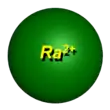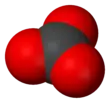Radium carbonate
Radium carbonate is a compound of radium, carbon, and oxygen. This salt is a poisonous, radioactive, amorphous,[4] white powder that is used in medicine.[2] It is notable for being more soluble than barium carbonate, unlike other radium compounds. Even though it is insoluble in water, it is soluble in dilute acids and concentrated ammonium carbonate.[5]
| |||
| Names | |||
|---|---|---|---|
| IUPAC name
Radium carbonate | |||
| Identifiers | |||
3D model (JSmol) |
|||
| |||
| |||
| Properties | |||
| RaCO3[2] | |||
| Molar mass | 286.0089 g[3] | ||
| Appearance | white powder[2] | ||
| insoluble[2] | |||
| Hazards | |||
| Main hazards | radioactive | ||
| Related compounds | |||
Other cations |
Beryllium carbonate Magnesium carbonate Calcium carbonate Strontium carbonate Barium carbonate | ||
Except where otherwise noted, data are given for materials in their standard state (at 25 °C [77 °F], 100 kPa). | |||
| Infobox references | |||
Preparation
Radium carbonate can be produced by using Ra2+ ions and carbonate:[6]
Ra2+ + CO32- → RaCO3.
Because of the very low solubility of this salt, it will form a white precipitate.
Reactions
Radium carbonate can be used to produce radium nitrate and other radium salts:
RaCO3 + 2HNO3 → Ra(NO3)2 + H2O + CO2
References
- "Radium carbonate - Hazardous Agents | Haz-Map". Haz-Map. Retrieved 2020-11-30.
- "Radium carbonate | Article about radium carbonate by The Free Dictionary". The Free Dictionary By Farlex. Retrieved 2020-11-30.
- "RADIUM CARBONATE - (7116-98-5) - Physical Properties • Chemical Properties • Solubility • Uses/Function • Reactions • Thermochemistry". Chemistry-Reference.com. Retrieved 2020-11-30.
- "Radium carbonate CAS#: 7116-98-5". Chemical Book. 2017. Retrieved 2020-12-03.
- "The Radiochemistry of Radium". Office of Scientific and Technical Information. Retrieved 2021-01-08.
- Richard C. Ropp. Encyclopedia of the Alkaline Earth Compounds. Elsevier, 2013. pp 370-371. Radium Carbonate
This article is issued from Wikipedia. The text is licensed under Creative Commons - Attribution - Sharealike. Additional terms may apply for the media files.

